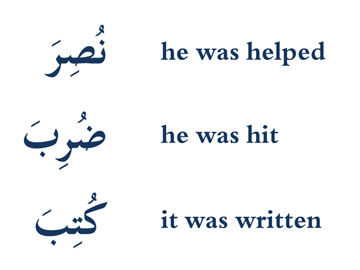Arabic is incredibly logical and beautifully structured. Very much like math.
Take a set of base letters, apply different patterns of vowels and extra letters to it and you can make dozens of words. Each new pattern you learn is like a new formula. Once you know it, you can apply it on thousands of sets of base letters and instantly expand your vocabulary.
Patterns in Arabic are like suffixes and prefixes in English. It's like how we add "ism" to describe a doctrine, "ly" to create an adverb, "ive" to create and adjective, etc.
Now, unlike in English, where prefixes and suffixes are only added to the beginning and end of the word, patterns in Arabic cause changes all over the word. Extra letters that come from the pattern may be added to the beginning of the word, in the middle or at the end.
And then there are the vowels. Because the letters in the Arabic alphabet are all consonants, you need to add vowels just to make pronunciation possible.
These vowels come in the form of diacritical marks (a.k.a. tashkeel, harakaat or zabr, zer, pesh).
Besides making words pronounceable, vowels also add meaning to the words. Different patterns of vowels will add different meanings to the base letters.
For example, look at these three words with the same base letters and different vowels:
All these words have something to do with knowledge, but they're different words and different types of words (noun, verb, active, passive) because of the pattern of vowels they carry.
Now, which sets of vowels give which meanings?
That's basically subject matter of the entire science of Sarf (Morphology) -- which is a bit much to cover at the moment.
What I did want to talk about is how we express or describe the patterns of vowels and extra letters that give the base letters added meaning.
This is the part that's like algebra.
For example, you could say:
If you want to express a past tense verb with a passive meaning, put a dhammah on the first base letter, a kasrah on the second one and a fatha on the third.
Take a set of base letters, apply different patterns of vowels and extra letters to it and you can make dozens of words. Each new pattern you learn is like a new formula. Once you know it, you can apply it on thousands of sets of base letters and instantly expand your vocabulary.
Patterns in Arabic are like suffixes and prefixes in English. It's like how we add "ism" to describe a doctrine, "ly" to create an adverb, "ive" to create and adjective, etc.
Now, unlike in English, where prefixes and suffixes are only added to the beginning and end of the word, patterns in Arabic cause changes all over the word. Extra letters that come from the pattern may be added to the beginning of the word, in the middle or at the end.
And then there are the vowels. Because the letters in the Arabic alphabet are all consonants, you need to add vowels just to make pronunciation possible.
These vowels come in the form of diacritical marks (a.k.a. tashkeel, harakaat or zabr, zer, pesh).
Besides making words pronounceable, vowels also add meaning to the words. Different patterns of vowels will add different meanings to the base letters.
For example, look at these three words with the same base letters and different vowels:
All these words have something to do with knowledge, but they're different words and different types of words (noun, verb, active, passive) because of the pattern of vowels they carry.
Now, which sets of vowels give which meanings?
That's basically subject matter of the entire science of Sarf (Morphology) -- which is a bit much to cover at the moment.
What I did want to talk about is how we express or describe the patterns of vowels and extra letters that give the base letters added meaning.
This is the part that's like algebra.
For example, you could say:
If you want to express a past tense verb with a passive meaning, put a dhammah on the first base letter, a kasrah on the second one and a fatha on the third.
That's correct. But it's a bit awkward.
So instead, we use a formula, or model pattern, where ف represents the first base letter, ع represents the second base letter and ل represents the third base letter. It's a convenient convention.
So now you can express the same rule by saying:
If you want to express a past tense verb with a passive meaning, use the pattern of فُعِلَ.
To make the word you want, you need to substitute your base letters into the فعل letters.
For example,
Let's do another one:
The one doing the verb (active participle): فَاعِل.
And just one more example for now:
The one who had the verb done to them (passive participle): مَفْعُول.
It's a little bit like algebra, isn't it?




oh darn! I was hoping to make this my domain name but guess you beat me to it! Nice website.
ReplyDeleteI was looking for these arabic words meaning and found it here on your blog about arabic love quotes. I am thankful to you for this buddy :)
ReplyDelete